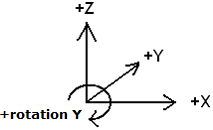Coordinate Systems
Global coordinate system
- | is right-handed |
- | the positive X axis is directed from the left to the right |
- | the positive Z axis is directed from the bottom to the top |
- | the positive Y axis drills in to the XZ plane |
- | the rotation about the Y axis is positive when measured clockwise |
|
- | The GCS is used for coordinates |
- | in general, the positive surcharge is assumed to act in the opposite direction to the positive axis and the positive rotation follows the positive sense of the global rotation |
- | particular definitions of the positive direction must be carefully examined for all cases |
Surcharge
- | is always assumed to act along the horizontal line (or at a point) |
- | the origin (point) and the length are the required input data |
- | the positive surcharge at zero angle is assumed to act in the opposite direction to the positive direction of the Z axis |
- | the zero angle corresponds to vertical surcharge |
- | the angle increases clockwise |
- | the angle ranges from <-180º to 180º> |
|
Anchors
- | an anchor can also be specified by the origin and an angle |
- | the zero angle corresponds to the direction of the X axis |
- | the angle increases clockwise |
|
- | the angle ranges from <-180º to 180º> |
Prescribed displacements and rotation of supports
- | prescribed displacements are positive in the directions of the X, Z axes and about the Y axis |
- | displacements are positive when developed in the opposite direction to the positive directions of the coordinate axes |
|
- | the positive rotation is measured clockwise |
Load of beams
- | the local coordinate system is right-handed |
- | the positive XL axis of the beam is assumed in direction from the starting to the end point |
- | the positive ZL axis is perpendicular and rotated counterclockwise by 90º from the beam axis |
- | load can be applied three directions: |
- global Z | |
- global X | |
- local normal (Z) | |
- | the positive load in the global direction acts in the opposite direction to the positive direction of the corresponding axis |
- | the positive load in the normal direction acts in the opposite direction to the positive direction of the local ZL axis |
- | the positive load angle α is measured clockwise |
- | the moment is positive when acting clockwise |
|
- | definition of load along the XL axis |
- coordinates, coordinates of the origin | |
- load span | |
- | types of load (always in above mentioned directions) |
- concentrated force | |
- concentrated moment | |
- distributed uniform over the entire beam | |
- distributed trapezoidal over the entire beam | |
- distributed uniform over a segment of the beam | |
- distributed trapezoidal over a segment of the beam |
Stresses and strains
- | positive normal stress Sigma corresponds to compression, negative to tension |
- | positive normal strain Epsilon corresponds to compression, negative to tension |
Internal forces along beams
- | positive normal force corresponds to tension, negative to compression |
- | positive normal strain Epsilon corresponds to compression, negative to tension |




